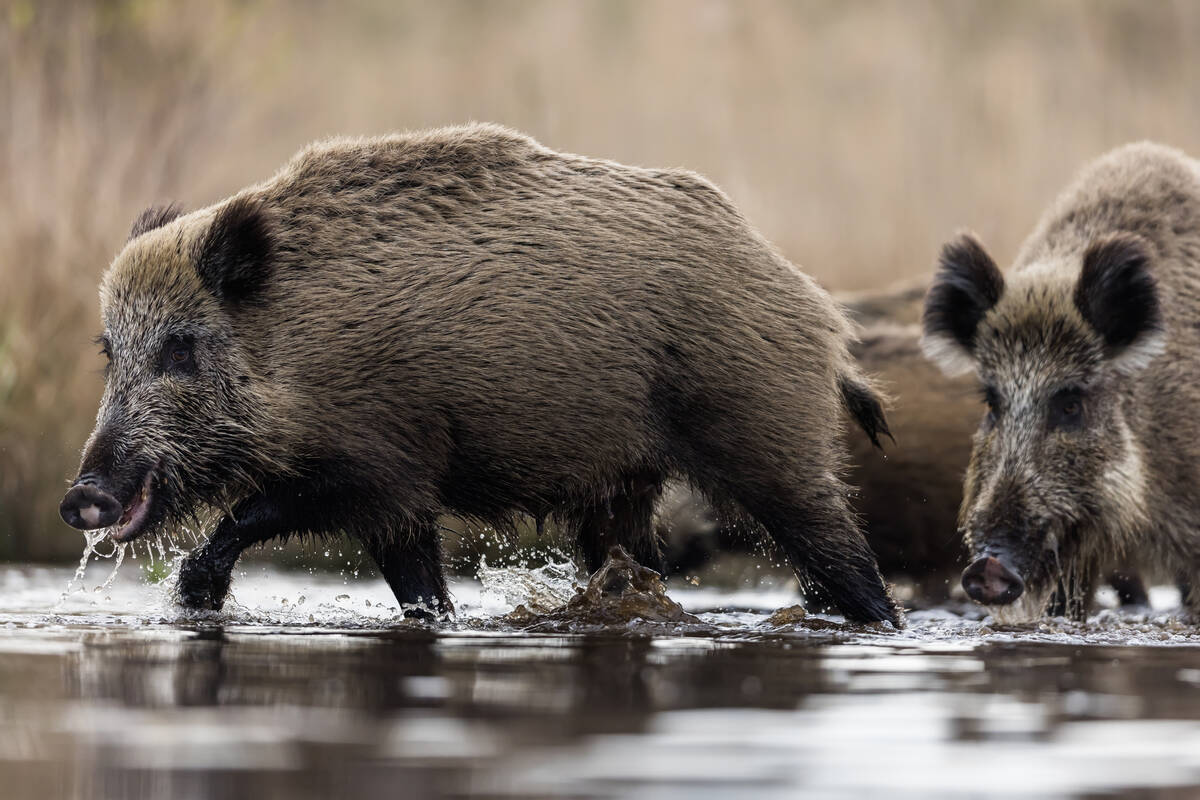The high water mark has risen in the cattle business, and it is floating bull sale prices to some of its highest levels in years.
Brian Good, director of field services with the Canadian Angus Association, has seen sharp spikes in bull prices before, but he has never seen bull sale averages as high as they are this winter.
“I have seen high prices before with the odd one to bring a big dollar, but not the average being $8,000 to $10,000,” said Good, who has travelled to a dozen bull sales this winter.
Read Also

Manitoba bans wild boar possession
Manitoba has tightened the regulatory status of Eurasian wild boar in an effort to help fight back against invasive wild pigs.
He estimated that prices for good bulls are up 30 to 40 percent over last year.
“The atmosphere is really good. People are prepared to pay more for bulls, for good bulls, especially,” he said.
“I don’t really care about these high priced bulls, I am looking more at the commercial end of it. If you get one at $24,000 and the rest averaging $7,500, that’s a pretty good sale.”
Terry White, program manager with Alta Genetics, has also seen the price of bulls jump this year.
White’s rule of thumb has been that three fat steers will buy one good herd bull. This year cattle producers need four fat steers to buy a good herd bull.
Like Good, White focuses more on the sale average than the high-priced bulls.
“You always see those high ones, but it’s what the cowboys are paying,” he said. “What drives this industry is the cow/calf buyer, the rancher. The $100,000 bulls don’t drive the industry.”
Good prices for cull cattle, calves and feeder animals means producers are willing to pay higher prices for bulls.
A black Simmental bull that sold for $170,000 at the Lewis Farms sale wasn’t a record breaking Canadian price, but it still felt pretty good, said Ken Lewis of Spruce Grove, Alta.
“We’ve never broken the hundreds before.”
A red Simmental bull at the same sale sold for $85,000.
The average price for the 307 red, black and Fleckvieh Simmentals and red and black Angus at the Lewis Farms sale was $9,279, up from last year’s $6,800 sale average.
Lewis said there was lots of interest in the black Simmental bull, Riddler, before the sale and wasn’t surprised it was the high seller.
It sold to Bouchard Livestock, a semen marketer, and Ashworth Farm and Ranch of Oungre, Sask.
Lewis said the overall higher prices are exciting.
“We have singled out a couple of high selling bulls, but what is more important is there are some economics in raising beef cattle today, and to aggressive cattlemen, bull power is always the way to improve their cow herd.”
A weaker Canadian dollar, lower grain prices and higher cattle prices are all giving cattle producers a mental boost to spend more at bull sales, he said.
The high selling bull at the three-farm Herd Master Simmental bull sale in Camrose, owned by Rancier Farms, sold for $52,000, while a full brother sold for $47,000.
The average price for the 130 bulls from the three farms at the sale was $10,400.
“There is so much excitement in the industry, so much optimism,” Rancier said during the sale.
“When prices are good, you can afford to pay more,” said Rancier, who plans to continue investing in his cattle operation.
“We want to focus hard on our cow family, do more embryos, more transplant work and work on our best cows.”
Dave Prokuda of Pro-Char Char-olais from Glenevis, Alta., said the bull sale averages at his sale jumped from $5,700 last year to $7,500 this year, excluding the top-selling $155,000 bull.
It was a previous three-way partnership of a high-selling Charolais bull, but the partnership ended and Prokuda bought it back in a bidding war at the sale.
He said the 350 producers in the audience and 250 online bidders were happy to pay higher prices for the bulls.
“I raise bulls for the commercial guys. The commercial guys are just happy. They’re spending $7,000 and they’re happy,” he said.
Key to a good sale is a repeat customer, said Prokuda. One buyer bought four two-year-old bulls over the phone, sight unseen, for $9,000 each.
Another customer paid $11,000 for a bull to put in with his heifers and was happy to pay the higher prices for the bull, he said.
Prices have also been higher in the United States.
The 120 Hereford bulls at the Colyer Hereford and Angus sale in Bruneau, Idaho, averaged US $9,835, and the 60 Angus bulls averaged $8,871.
Prices at the Bruns Angus Online sale in Madison, South Dakota, averaged $7,902 for 92 yearling bulls.
Good isn’t surprised cattle producers are paying more for bulls.
“It all boils down to the fact they’re getting more money for their calves and they’re willing to pay more money for a good bull. It’s pretty simple.”














